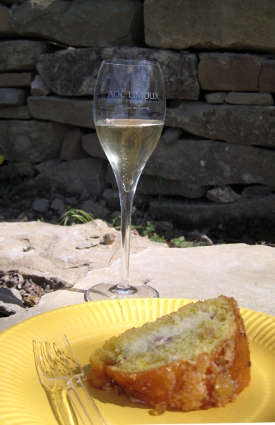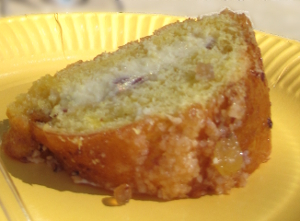King Cake with wine? Mon Dieu, you say! Not so fast. Mardi Gras means King Cake, and we have just the recipe and wine recommendation to enjoy your own Fat Tuesday celebration!
(Note: Part of this article originally appeared last year, we've updated it to include the 2018 dates for Mardi Gras in the United States and Limoux Carnival, in the Pyrenees-Mediterranean region of Limoux.)
 In the United States’ Christian traditions, Mardi Gras ( Shrove Tuesday or Fat Tuesday) is the Tuesday before Lent when those preparing to fast celebrate with rich fatty foods, wine and perhaps a bit of debauchery. Beads, candy and trinkets fly from parade floats into the hands of welcoming Carnival celebrants and briefly bare-chested women. The call “Hey mister, throw me some beads,” can often be answered with “Show us your tits!” But this is all voluntary, and no one takes liberties in bestowing some gaudy golden glitter on an unsuspecting maiden, simply because he has amassed alleged mountains of wealth.
In the United States’ Christian traditions, Mardi Gras ( Shrove Tuesday or Fat Tuesday) is the Tuesday before Lent when those preparing to fast celebrate with rich fatty foods, wine and perhaps a bit of debauchery. Beads, candy and trinkets fly from parade floats into the hands of welcoming Carnival celebrants and briefly bare-chested women. The call “Hey mister, throw me some beads,” can often be answered with “Show us your tits!” But this is all voluntary, and no one takes liberties in bestowing some gaudy golden glitter on an unsuspecting maiden, simply because he has amassed alleged mountains of wealth.
While the United States’ celebrations last a few weeks, in France’s Occitania, Pyrenees-Mediterranean region of Limoux the party is just getting started. Dubbed the longest in the world, this year’s the Limoux Carnival runs from January 7 to March 18, 2018. This year Mardi Gras in the New Orleans falls on Tuesday, February 13.
It’s a tradition carried on for the past 400 years, when 14th Century millers (grinders of food stuffs and grain) celebrated payment of their taxes to Prouille Monastery on a certain Shrove Tuesday. Limoux tradition since then involves not so much a parade, but a kind of dance, governed by rules handed down from generation to generation. Nowadays, on Saturdays and Sundays in January, February and March, 30 or so groups take turns as the masked participants parade through the streets dancing from one cafe to the next. After the third month, the festivities culminate with the Majesté Carnaval and la Nuit de la Blanquette (Night of the Blanquette) when this sparkling wine, which predates Champagne, flows freely.
We first tasted Blanquette de Limoux after a trek through the Languedoc region vineyards, where they served a special cake. They told us it was just after the special Limoux Carnival, but I did not make the connection. When we returned home, I asked Caryl Panman, proprietor of Château Rives-Blanques (along with husband Jan), who makes one of our favorite Blanquette de Limoux, for the recipe. It was then I discovered the origins of our own Mardi Gras King Cake.
Limos and the origins of the Mardi Gras King Cake
The Limos is the Limoux version of the famous French galette des rois, the King Cake, one of the oldest pastries in France, says Caryl. She tells us there are two versions of the cake: the galette and the gateau and every region has its own way of making them. The French consume nearly twenty million of them every year, around Epiphany (celebrated on the second Sunday following the 25th of December). “Limoux’s is traditionally a gateau, but quite different from the others,” she says.
Traditionally, the youngest person goes under the table, and from there calls the name of whoever he chooses to get the piece that’s being sliced above his head. One of those slices will have a bean, or an ornamental charm in it – and the person who gets that is king for the day – and has to buy the next galette.
Ah, that’s our Mardi Gras King Cake, I say to her! Caryl goes on to explain its origins:
This “cake of kings” was first associated with Roman pagan festivals, Caryl says. In the third century BC, the Romans celebrated Saturn, the god of grain and agriculture, in a Saturnalian festival of drink and debauchery. A round and golden cake made its appearance then, in which was hidden a white or black legume bean. If a slave – who had been made noble for the feast days – found the bean in his slice, he was crowned King for a day, and then … put to death after the party was over.
“Not very nice,” she says.
But then the King Cake tradition evolved. Byzantine monks in the 14th century adopted a tradition of sharing a “cake of kings.” But instead of cake, they made a brioche, and hid a little coin or trinket in it. At Epiphany, whoever got the lucky slice was made Chapter Master. Limoux’s famous version is also a brioche.
Caryl tells us that the original recipe of the frangipane cake, a great puff of pastry filled with almond paste, butter and sugar (the galette), is attributed to Pompeo Frangipani, Marshal of France under Louis XIII in the sixteenth century. The Italian marquis invented a perfume made from almonds. His pastry chef was inspired to use it as a flavoring for the cream in the cake. Catherine de Medici, second wife of Henry II, then imported the recipe to France.
“Over time, the bean inside the cake became a porcelain bean,” she says. These days, she tells us, almost anything goes.
“There’s a baker in Calvados who advertises that two of his galettes des rois have a solid gold bar worth €400 (about $425 US) in them – possibly inspired by the famous fairytale, written by Charles Perrault in 1694, in which Princess Donkey Skin looses her ring in the dough.
As for Limoux, Caryl tells us, their Galette des Rois is arguably the best version, “and certainly the most fattening,” she says.
“Whereas most places will eat their King Cake around Epiphany, Limoux will continue serving it up throughout carnival. Here we have the added advantage that Limoux’s carnival is the longest in the world: it begins around January, and ends the Sunday before Palm Sunday – that’s three whole months of Limos eating!” Caryl kindly gave us a recipe for the Limos.
Gâteau des rois aux fruits confits, the Limos (King’s Cake with Candied Fruits)
Ingredients:*
 1 lemon
1 lemon
1 orange
50 g sugar, Sugar crystals for decoration, Candied fruit
50 g butter
pinch of salt
25 g rum plus rum for macerating fruit
50 g water
250 g orange flower water
250 g flour
2 eggs plus egg yolk for brushing
10 g yeast
*use a digital scale if you usually consult recipes in American cooking measurements. Don’t know which one to buy? Try here.
See the full recipe with directions, here, on our previous post Mardi Gras: Pairing Wine with King Cake (Galette des Rois)
Laissez les bon temps rouler!
The WineWonkette

